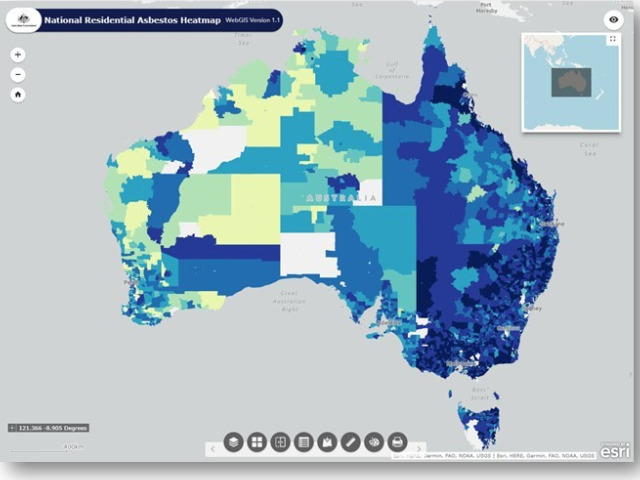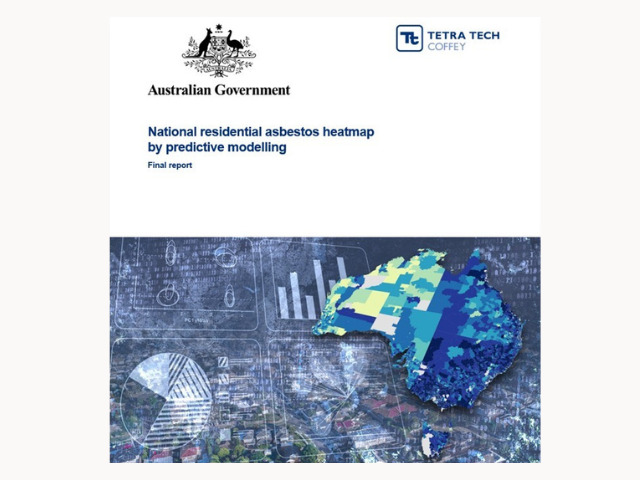
Tetra Tech Coffey was recently engaged to develop a national residential asbestos heatmap by predictive modelling to be used in the management of asbestos in the Australian residential environment. We joined two of Tetra Tech’s Principal Geospatial Consultants, Chapal Choudhury and Grant Young, as they share their insights into this exciting project that is bringing together AI and experts from across Tetra Tech to help solve this problem in our built environments.
When you think about asbestos identification, you don’t normally think of Artificial Intelligence, so tell us more about this project?
Chapal Choudhury – Last year, the Australian government’s Asbestos Safety and Eradication Agency (ASEA) approached the market for the provision of a national residential asbestos heatmap. We were subsequently engaged on the project and have been working closely with ASEA on this research project for the past seven months.
Australia’s extensive past use of asbestos has left a harmful legacy in the built environment. Approximately 1.9 million tonnes of raw asbestos were consumed in Australia, and it is estimated that this was manufactured into 13 million tonnes of asbestos containing material (ACM). Approximately 40% of these ACMs were used in domestic building products. Several million tonnes are estimated to remain in the built environment today. The heatmap is the first attempt to broadly show the likelihood of ACM presence and absence in the residential environment.
Due to the scarcity of adequate and location-specific residential asbestos data, a predictive modelling approach using artificial intelligence (AI) and machine learning (ML) technologies was applied to predict ACM likelihood in residential environment across all States and Territories in Australia.
What services did Tetra Tech provide for the project?
Grant Young – It is predominantly a Geographic Information System (GIS) project and was led by our geospatial team. Supporting us, and bringing the artificial intelligence and machine learning expertise, is our Tetra Tech Delta team (Kateri Salik, PhD Environmental Data Scientist and Brian Pickard, PHD Geospatial Scientist) in the USA. And of course, Tetra Tech Coffey in Australia also provided our technical domain knowledge in asbestos.

How did Tetra Tech deliver the project?
Chapal Choudhury – The project required three areas of expertise. One is geospatial, data and GIS; the second being the predictive modelling component, AI/ML and data analytics; and the third area is asbestos domain knowledge. At Tetra Tech, we are known for bringing together the best specialists, and we have great coverage over these three discrete areas of expertise.
As Grant mentioned, we have our geospatial team here in Melbourne, Australia, our Tetra Tech Delta team in North Carolina, USA, and our occupational hygiene teams based on both our west and east coasts in Australia. So, the project is a great example of global collaboration across Tetra Tech.
We also engaged the University of New South Wales’ City Future Research Centre as an Australian-based reinforcement to our AI/ML expertise (Hoon and Chris in Sydney). UNSW really rounded off our team to deliver this first-of-its-kind project.
You worked with Tetra Tech Delta here. Tell us a bit more about this collaboration?
Grant Young – Tetra Tech aims to bring together expertise from different businesses, and Tetra Tech Delta focuses on digital, data analytics, artificial intelligence, and machine learning. What we are seeing here is how Tetra Tech can deliver solutions that combine science and engineering expertise with advanced analytics and technology.
As part of the Tetra Tech Delta team ourselves, it was exciting to have ‘within-Delta’ collaboration on this project, and this was the first time we’ve led a project with a significant AI component. There’s so much we will gain from this experience, and the potential for incorporating this technology on future projects is significant. It really demonstrates our Leading with Science® approach.
It has been awesome to be part of project that is helping to manage national health and safety issues.
ASEA recently provided this feedback to the project team at Tetra Tech Coffey:
A big thank you to all of you for bringing to fruition the first ever national residential asbestos heatmap. This is a game-changing achievement for our agency, creating the solid evidence base needed to take action in this important space. We have thoroughly enjoyed collaborating with all of you on this important project over the last 7 months,and hope you have appreciated learning more about Australia’s asbestos legacy from us, as much as we have loved soaking up data analytics and AI expertise from you. We look forward to continuing working with you in the next critical phase, as we launch the heatmap with our stakeholders in the upcoming roadshows.

For more information on this project visit the Australian government’s Asbestos Safety and Eradication Agency
You can also contact
Chapal Choudhury, Principal Geospatial Consultant chapal.choudhury@tetratech.com or Grant Young, Geospatial Leader, Principal Geospatial Consultant grant.young@tetratech.com